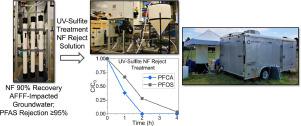Water Research ( IF 12.8 ) Pub Date : 2021-09-22 , DOI: 10.1016/j.watres.2021.117677 Charlie J Liu 1 , Garrett McKay 2 , Daqian Jiang 3 , Raul Tenorio 4 , J Tani Cath 4 , Camille Amador 4 , Conner C Murray 4 , Juliane B Brown 4 , Harold B Wright 5 , Charles Schaefer 6 , Christopher P Higgins 4 , Christopher Bellona 4 , Timothy J Strathmann 4

|
Previous laboratory scale studies indicate nanofiltration (NF) and UV-sulfite photochemical treatments as promising technologies for the removal and destruction, respectively, of per- and polyfluoroalkyl substances (PFASs) from contaminated water. This study reports on a field demonstration of a pilot-scale hybrid NF and UV-sulfite treatment train for the remediation of 12 PFASs detected in groundwater impacted by aqueous film-forming foam (AFFF) at a U.S. Department of Defense installation. For most of the detected PFASs, NF rejection was consistently ≥95% over a 30-day field trial when operating at 90% total permeate recovery. Rejection of short-chain perfluorosulfonic acids (PFSAs) by NF decreased when recoveries increased from 90 to 97%; tests with a reverse osmosis (RO) membrane showed ≥99% rejection of all PFASs regardless of increasing recovery. UV treatment of the NF reject following 90% permeate recovery resulted in variable destruction of individual PFASs, with rates also being dependent on pH and the identity and concentration of UV photosensitizer. Rates of perfluorocarboxylic acid (PFCA) degradation were greater than those measured for PFSAs and perfluoroalkyl acid (PFAA) precursors and were independent of perfluoroalkyl chain length. In contrast, rates of PFSA degradation increased with increasing chain length. Consistent levels of PFAS degradation by UV-sulfite were observed during a 30-day demonstration experiment in NF reject water amended with 10 mM sulfite and adjusted to pH 11.2. Collectively, >75% of the detected PFAS mass in the NF reject was destroyed after 4 h of UV treatment, increasing to >90% after 8 h of treatment. An analysis of electrical energy inputs for the hybrid NF/UV-sulfite treatment train showed energy per order magnitude (EE/O) requirements ranging from ≤13.1 kWh/m3 for all PFCAs and 14.1 kWh/m3 for PFOS to values >100 kWh/m3 for more recalcitrant short-chain PFSA analogues. The UV reactor and water-cooling system were the major contributors to overall energy requirements and represent the greatest opportunities for improving efficiency of the technology.
中文翻译:

针对受全氟和多氟烷基物质 (PFAS) 污染的地下水进行混合纳滤和紫外线亚硫酸盐处理系统的中试现场演示
以前的实验室规模研究表明,纳滤 (NF) 和紫外线亚硫酸盐光化学处理是分别从受污染的水中去除和破坏全氟烷基物质 (PFAS) 的有前途的技术。本研究报告了中试规模的混合 NF 和紫外线亚硫酸盐处理系统的现场演示,用于修复在美国国防部装置中受水性成膜泡沫 (AFFF) 影响的地下水中检测到的 12 种全氟和多氟烷基物质。对于大多数检测到的 PFAS,在 30 天的现场试验中,当以 90% 的总渗透回收率运行时,NF 拒绝率始终≥95%。当回收率从 90% 增加到 97% 时,NF 对短链全氟磺酸 (PFSA) 的排斥减少;使用反渗透 (RO) 膜进行的测试表明,无论回收率如何提高,所有 PFAS 的截留率均≥99%。在 90% 的渗透回收率后对 NF 拒绝物进行紫外线处理导致单个 PFAS 的不同破坏,其速率还取决于 pH 值以及紫外线光敏剂的特性和浓度。全氟羧酸 (PFCA) 降解的速率大于 PFSA 和全氟烷基酸 (PFAA) 前体的降解速率,并且与全氟烷基链长度无关。相比之下,PFSA 降解率随着链长的增加而增加。在用 10 mM 亚硫酸盐修正并调节至 pH 值 11.2 的 NF 废水中进行了 30 天的演示实验期间,观察到紫外线亚硫酸盐对 PFAS 的降解水平一致。总而言之, > 在紫外线处理 4 小时后,NF 废料中检测到的 PFAS 质量的 75% 被破坏,处理 8 小时后增加到 >90%。对混合 NF/UV-亚硫酸盐处理系统的电能输入分析表明,每级能量 (EE/O) 要求范围为≤13.1 kWh/m3对于所有全氟羧酸和14.1千瓦时/米3为PFOS到值> 100千瓦时/米3为更顽固短链PFSA类似物。紫外线反应器和水冷系统是整体能源需求的主要贡献者,代表了提高技术效率的最大机会。


























 京公网安备 11010802027423号
京公网安备 11010802027423号